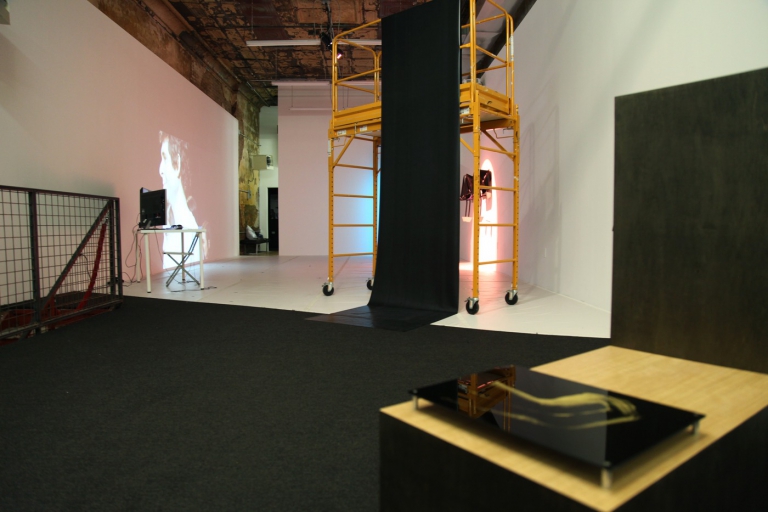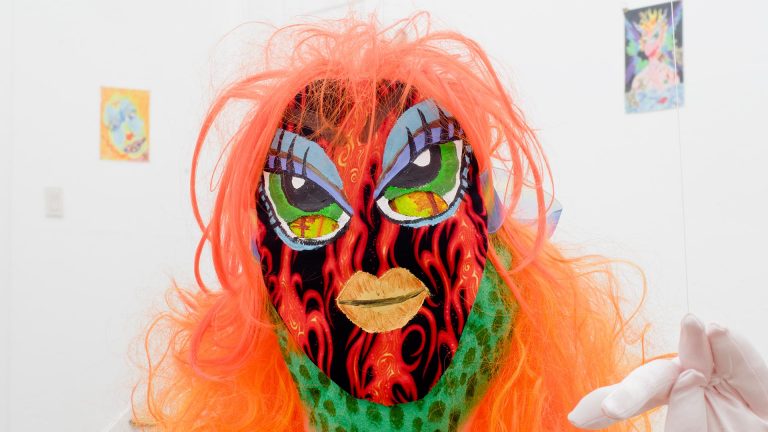Artist: Kim Farkas
Exhibition title: Permaculture
Venue: Tara Downs, New York, US
Date: September 8 – October 16, 2021
Photography: all images copyright and courtesy of the artist and Tara Downs, New York
Kim,
I was surprised to learn that “permaculture” is a portmanteau for “permanent culture.” This permanence is one not of essentialized fixity, but achieved through the ongoingness of doing— a flexible system that ensures sustainability. I’ve spent quite a lot of time during the last few years grappling with what it means for me to be a culture worker in this place and this time. I was doubtful about the possibilities of this culture work being either very fruitful or sustainable.
In a transnational collaboration that obliquely resonates with our own biographies, Françoise Lionnet and Shu-mei Shih, respectively a Mauritian-French scholar in African American studies and a Korean-born Chinese working in Asian American studies, open their co-edited volume Minor Transnationalism with a co-authored text that encourages a shifting of attention to encounters among diasporic subjects:
“We realized, in retrospect, that our battles are always framed vertically, and we forget to look sideways to lateral networks that are not readily apparent… The dominant is posited, even by those who resist it, as a powerful and universalizing force that either erases or eventually absorbs cultural particularities.” [1]
Looking sideways is effortful. Your Chinatown [2] is qualified by Paris, this one by New York. How seemingly impossible it is to tear the attention away from the colonial histories that name and shape these places.
Looking sideways is effortless. Diaspora is a practice that is always already hybrid, in dialogue, in translation. As you’ve told me, the « témoin lumineux » is an indicator light that says, “We’re still here.”
Who is the we, though?
In the introduction of Orientalism, Edward Said quotes from Gramsci’s Prison Notebooks: “The starting point of critical elaboration is the consciousness of what one really is, and is ‘knowing thyself’ as a product of the historical process to date, which has deposited in you an infinity of traces, without leaving an inventory… therefore it is imperative at the outset to compile such an inventory.”
The ability to refer to the “we” of an ethnic group has its uses, particularly when the “we” has been rendered elusive by complex histories of colonization, diaspora, displacement, and erasure.
As you know, the name for your maternal ancestors, the Peranakan, has shifting meanings depending on the context of its usage. It points to both people and place—“descendants of” or “from the “wombs of,” but I’m most drawn to its connotations of “locally born but non-indigenous” and “hybrid.” I also recently learned that the word “diaspora” was originated to refer to your paternal Jewish ancestors.
The resin in your work has also always been a kind of témoin, testifying to the materials and technologies of our time, collapsing traces of your forebears and kindred spirits into an inventory for those to come. I think of this work as permaculturally Peranakan—an evolving system that collapses disparate geographies, time periods, and corresponding shifts in relationship to objects, codes, and practices. Lionnet and Shih also refer to a “politics of retrieval,” gestures through which the diasporic subject grapples with authenticity and a return to a culture made distant through assimilation. We—you and I, diasporic culture workers, minor transnationals—work with what we have at hand. Our participation might be weighted towards the center, but continues sideways through strain, through instinct, through those who call our attention to the point of entanglement that is the elsewhere.
I’ve chosen the epistolary format to respond to Permaculture because this writing is just that: one momentary response in an endless process of encounters. I’ve been returning to a line from Fred Moten’s Black and Blur in which he describes “a reconfiguration of the concept of writing as that which occurs where performance and recording converge at the site of a bodily inscription.” Correspondence, like your custom composites, is a particular kind of inscription [3], which perhaps more readily reveals the convergence of bodies and the written word, disturbing staid understandings of producer and produced.
I know that what has been vital for you has never been simply the objects of production, but the systems that produce them that go more or less unseen. If what is made is an occasion for more lateral encounters, even if they are uncomfortable, then I think culture is performing as it should.
Looking at you sideways, from over here, as always
Ana
[1] Lionnet, Françoise., and Shumei Shi. Minor Transnationalism. Duke University Press, 2005
[2] In an American conversational context, I do refer to the neighborhood where Kim lives in Paris as one of the city’s two “Chinatowns,” though in French they traditionally have not had proper names, but rather descriptors: « les quartiers chinoi s » or « les quartiers asiatiques ». A campaign to rebrand as Chinatown Paris is underway. From my vantage point in Los Angeles, I am unsure whether to read this campaign as an act of self-affirmation of a diasporic Chinatown culture, or as a vehicle of gentrification. Perhaps it is both.
[3] Moten, Fred. Black and Blur. Duke University Press, 2017
Exhibition View, Kim Farkas: Permaculture, 2021, Tara Downs, New York, Image courtesy of the artist and Tara Downs, New York Photo: Daniel Terna
Exhibition View, Kim Farkas: Permaculture, 2021, Tara Downs, New York, Image courtesy of the artist and Tara Downs, New York Photo: Daniel Terna
Exhibition View, Kim Farkas: Permaculture, 2021, Image courtesy of the artist and Tara Downs, New York Photo: Daniel Terna
Kim Farkas: Permaculture, 2021, Image courtesy of the artist and Tara Downs, New York Photo: Daniel Terna
Kim Farkas: Permaculture, 2021, Image courtesy of the artist and Tara Downs, New York Photo: Daniel Terna
Kim Farkas: Permaculture, 2021, Image courtesy of the artist and Tara Downs, New York Photo: Daniel Terna
Exhibition View, Kim Farkas: Permaculture, 2021, Image courtesy of the artist and Tara Downs, New York Photo: Daniel Terna
Exhibition View, Kim Farkas: Permaculture, 2021, Image courtesy of the artist and Tara Downs, New York Photo: Daniel Terna
Exhibition View, Kim Farkas: Permaculture, 2021, Image courtesy of the artist and Tara Downs, New York Photo: Daniel Terna
Exhibition View, Kim Farkas: Permaculture, 2021, Image courtesy of the artist and Tara Downs, New York Photo: Daniel Terna
Exhibition View, Kim Farkas: Permaculture, 2021, Image courtesy of the artist and Tara Downs, New York Photo: Daniel Terna
Exhibition View, Kim Farkas: Permaculture, 2021, Image courtesy of the artist and Tara Downs, New York Photo: Daniel Terna
Exhibition View, Kim Farkas: Permaculture, 2021, Image courtesy of the artist and Tara Downs, New York Photo: Daniel Terna
Exhibition View, Kim Farkas: Permaculture, 2021, Image courtesy of the artist and Tara Downs, New York Photo: Daniel Terna
Exhibition View, Kim Farkas: Permaculture, 2021, Image courtesy of the artist and Tara Downs, New York Photo: Daniel Terna
Exhibition View, Kim Farkas: Permaculture, 2021, Image courtesy of the artist and Tara Downs, New York Photo: Daniel Terna
Exhibition View, Kim Farkas: Permaculture, 2021, Image courtesy of the artist and Tara Downs, New York Photo: Daniel Terna
Exhibition View, Kim Farkas: Permaculture, 2021, Image courtesy of the artist and Tara Downs, New York Photo: Daniel Terna
Exhibition View, Kim Farkas: Permaculture, 2021, Image courtesy of the artist and Tara Downs, New York Photo: Daniel Terna
Exhibition View, Kim Farkas: Permaculture, 2021, Image courtesy of the artist and Tara Downs, New York Photo: Daniel Terna
Exhibition View, Kim Farkas: Permaculture, 2021, Image courtesy of the artist and Tara Downs, New York Photo: Daniel Terna
Exhibition View, Kim Farkas: Permaculture, 2021, Image courtesy of the artist and Tara Downs, New York Photo: Daniel Terna
Exhibition View, Kim Farkas: Permaculture, 2021, Image courtesy of the artist and Tara Downs, New York Photo: Daniel Terna
Exhibition View, Kim Farkas: Permaculture, 2021, Image courtesy of the artist and Tara Downs, New York Photo: Daniel Terna
Exhibition View, Kim Farkas: Permaculture, 2021, Image courtesy of the artist and Tara Downs, New York Photo: Daniel Terna
Exhibition View, Kim Farkas: Permaculture, 2021, Image courtesy of the artist and Tara Downs, New York Photo: Daniel Terna
Exhibition View, Kim Farkas: Permaculture, 2021, Image courtesy of the artist and Tara Downs, New York Photo: Daniel Terna
Exhibition View, Kim Farkas: Permaculture, 2021, Image courtesy of the artist and Tara Downs, New York Photo: Daniel Terna
Exhibition View, Kim Farkas: Permaculture, 2021, Image courtesy of the artist and Tara Downs, New York Photo: Daniel Terna
Exhibition View, Kim Farkas: Permaculture, 2021, Image courtesy of the artist and Tara Downs, New York Photo: Daniel Terna
Exhibition View, Kim Farkas: Permaculture, 2021, Image courtesy of the artist and Tara Downs, New York Photo: Daniel Terna
Exhibition View, Kim Farkas: Permaculture, 2021, Image courtesy of the artist and Tara Downs, New York Photo: Daniel Terna





































